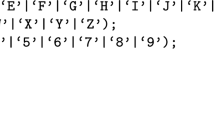Summary
We argue that physical reductionism is a one-sided view of science. While it has successfully guided detection of elementary building blocks in many domains of science, and reduction of different sciences to the elementary objects, properties and interactions in physics, it provides little help for other scientific activities and is particularly ill suited to describe analytical chemistry. Analytical chemistry focuses on (1) empirical meaning of chemical concepts and on (2) understanding the structure of any particular sample. The primary theoretical tool of analytical chemistry is (3) model construction. Considering that activities (1–3) are complementary to formation of reductionist theories, analytical chemistry is as much in the forefront of research as theoretical physics, expanding our knowledge in other, equally indispensable directions. In this paper we briefly describe (1) and (2), and then we concentrate on model formation and the role of models in science. Models combine knowledge of basic building blocks, knowledge of structure, and elements of empirical meaning. Models play an essential role in preparation for measurements and in developing new measurement procedures. They expand our capability for knowledge verification and systematization. They are critical in understanding the hidden structure of objects and processes and in identifying new phenomena. A model is a product of synthesis and describes structured objects and situations, usually complex, as combinations of basic elements. Basic elements are provided by reductionistic theories which are the product of knowledge analysis and describe simple elements of nature and their interaction viewed from a singular perspective of either gravity, or electromagnetism, thermal phenomena, and the like. Model construction, not theory construction, is a basic theoretical tool in domains such as chemistry, which study complex systems and phenomena. We analyse the process of model creation, pointing out that it oscillates between solvability of equations and adequacy of description. As an example we analyse model construction in the domain of ion selective electrodes.
Similar content being viewed by others
References
Berube TR, Buck RP, Lindner E, Gratzl M, Pungor E (1989) Anal Chem 61:453
Bridgman PW (1927) The logic of modern physics. Macmillan, New York
Buck RP (1968) Anal Chem 40:1432
Buck RP (1985) In: Pungor E (ed) Ion-selective electrodes, 4. Elsevier, Amsterdam
Carnap R (1936) Philos Sci 3
Dole M (1941) The glass electrode. Wiley & Sons, New York
Eisenman G (1969) In: Durst RD (ed) Ion-selective electrodes. NBS Spec Publ 314, Washington
Hulanicki A, Lewenstam A (1981) Anal Chem 53:1401
Janata J (1990) In: Ivaska A, Lewenstam A, Sara R (eds) Contemporary electroanalytical chemistry. Plenum Press, New York (in press)
Koryta J (1972) Anal Chim Acta 61:329
Lewenstam A, Hulanicki A, Sokalski T (1987) Anal Chem 59:1539
Lewenstam A, Zytkow JM (1989) In: Pungor E (ed) Ion-selective electrodes, 5. Akademiai Kiado, Budapest
Lindner E, Toth K, Pungor E (1988) Dynamic characteristics of ion-selective electrodes. CRC Press, Boca Raton
Morf WE (1981) The principles of ion-selective electrodes and of membrane transport. Akademiai Kiado, Budapest
Nikolskii BP (1937) Zh Fiz Khim 10:495
Nikolskii BP, Materowa EA (1985) Ion-Selective Electrode Rev 7:3
Przelecki M (1972) Studia Filozoficzne 1972:297
Pungor E, Toth K (1970) Analyst (London) 95:625
Sandifer JR (1989) Anal Chem 61:2341
Wojcicki R (1972) Studia Filozoficzne 1972:13
Wuhrman HR, Morf WE, Simon W (1973) Helv Chim Acta 56:1011
Zytkow JM (1974) In: Krajewski W, Mejbaum W, Such J (eds) Zasada korespondencji w fizyce a rozwoj nauki. Warszawa PWN
Zytkow JM (1982) In: Krajewski W (ed) Polish essays in the philosophy of the natural sciences. Reidel
Author information
Authors and Affiliations
Additional information
On leave of absence from Wichita State University
Rights and permissions
About this article
Cite this article
Żytkow, J.M., Lewenstam, A. Analytical chemistry; the science of many models. Fresenius J Anal Chem 338, 225–233 (1990). https://doi.org/10.1007/BF00323013
Received:
Issue Date:
DOI: https://doi.org/10.1007/BF00323013




